Etiquette rules for children are one of the important topics that parents should raise in their family in a timely manner. A person of any age living in a society must take into account the norms of behavior accepted by this society and follow them. The child’s place in society depends on how conscientiously parents raise their child.
Types of etiquette
Conventionally, etiquette for every day can be divided into two large groups. The first is generally accepted rules for all situations. The second is the rules of behavior in certain areas, for example, mourning, military, religious etiquette, and so on. There are also rules of dance etiquette, behavior in case of fire, and so on. Parents must clearly understand that teaching their child the rules of behavior should begin from an early age.

This process should occur gradually and in the form of a game. To begin with, the child is explained how to behave at the table, how to address an adult, and how to behave in a store. Later, you can learn other types of etiquette, for example, rules of conduct in a hospital, kindergarten, school, and so on.
Rules of conduct for preschoolers in pictures
You can teach your child etiquette both by example and by visual aids. You can explain how to behave in society and show illustrations. The book “Etiquette for Kids” in pictures by E. V. Sokolova and N. N. Yankovskaya is suitable for this.
When showing your child a picture, you can ask leading questions: “What do you think is shown here? How should you behave?" Let the child try to formulate the rules of behavior himself.

At what age should a child be taught rules of conduct?
Psychologists believe that introducing good manners to a child should begin from the first years of life, despite the fact that the conscious age begins at approximately 5 years. From the age of 2-3 years, it is important to tell a child how to behave at the table. At this stage of development, many toddlers are already eating on their own, which means that it’s time to learn the rules of good manners at the table.
Preschool children receive the necessary knowledge primarily from their parents. Later, etiquette is studied in kindergarten. This is how primary socialization takes place. By this age, the child should already clearly understand that there are situations in life in which he should show respect and politeness to his peers and older people.
Note to parents
It is difficult to name the exact age when you need to start teaching your child good manners. It is necessary to instill in a child norms of behavior with family members and society from birth, even when the child does not understand the whole essence. He understands the intonations, the mood of his family and sees the picture of what is happening.
The table below clearly illustrates the approximate age range when you can introduce your child to the rules of behavior.
Table “When and how to teach a child etiquette”
| Age | What to pay attention to |
| Up to 1 year | We use polite words in our speech (“thank you”, “please”, “good morning”, “good night”) |
| We wash our hands before eating, saying out loud why we need to do this | |
| 1-3 years | We instill neatness - use a bib or napkin, change soiled clothes after eating, wash your face and hands |
| We instill norms of behavior and communication in the family, showing by example respect and politeness | |
| We teach to eat with a spoon and fork, we replace the sippy cup with a mug | |
| 3-5 years | We improve the skill of using cutlery, teach how to eat carefully - do not move away from the table, lean towards the plate so as not to spill the soup, and not to spread “dirt” around you |
| We actively teach independent personal hygiene - brushing teeth, washing hands, using a handkerchief or napkin. | |
| We teach you to cover your mouth when coughing or sneezing; don’t forget about polite wishes addressed to another person (“Be healthy”) | |
| We introduce the child to the rules of behavior in public places, transport, at a party, at cultural events, in kindergarten | |
| 5-6 years | We continue to introduce the child to table etiquette, adding the use of a knife to everyday life |
| We improve our knowledge of guest etiquette, apply the rules if we go on a visit; we correct mistakes, explain to the child why some actions are unacceptable | |
| By our example we constantly show how to communicate in the family and in society outside it, we monitor our behavior | |
| School age | Let’s not forget everything we instilled in the child before; we remind you how to behave at the table (in the school canteen), in lessons (speech etiquette, respect for the teacher, peers), in transport (independent trips) and public places |
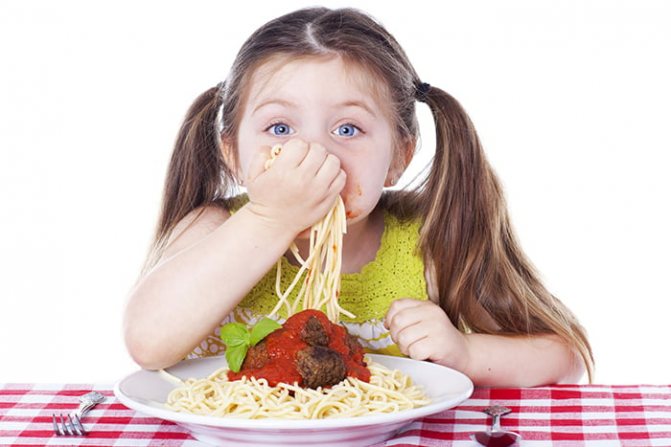
What should parents understand?
Children first learn rules of behavior from their parents. It is mom and dad who show their son or daughter an example of how to behave in a given situation. Parents must remember that the child follows their example in everything, so the behavior of adults must be thoughtful and balanced.

Mom and dad must remember that it is impossible to force their child to learn certain rules. This can only cause a protest from a son or daughter. Learning is best done while playing. For example, you can learn table etiquette by playing with dolls.
If parents behave competently, the child will certainly copy their manners. Good manners will also manifest themselves in society, which will help avoid awkward situations.
WHEN TO INVOLVE THE RULES OF GOOD TONE?
You can teach children rules of behavior from a young age, although awareness will come much later - after 5 years. Children should be introduced to table manners from the age of 2. The child is already quite capable of eating on his own, which means it’s time to start explaining how he can and cannot behave while eating.
Preschoolers are taught etiquette by their parents at home and by teachers in kindergarten. The baby is in the company of adults and children; situations arise around him every day that require politeness, respect for elders, and the ability to interact with peers.
When a child grows up and goes to school, his level of freedom will increase, and there will be less control from adults. All omissions of parents in upbringing will be clearly visible, and correcting the behavior of schoolchildren is not easy. That is why the rules of etiquette and ethics (the foundations of ethics and ethics) must be laid down from an early age.
Rules of speech etiquette
Good manners in children and adults are the key to their recognition in society. Let's list the main points regarding speech etiquette:
- In the morning you should say: “Good morning,” and before going to bed, say “Good night.”
- You need to say hello to your neighbors even when you don’t know them personally.
- When meeting with family and friends, you need to say hello, and say goodbye: “Goodbye.”
- It is important to know the words “Thank you”, “Please”, “be kind” and apply them in the appropriate situation.
- Address adult strangers and teachers as “you.”
- If some kind of trouble happened, for example, the child accidentally hit someone or broke something, you should apologize.
- If during a conversation a child wants to address an adult, you need to use the following words: “Can I ask” or “Sorry, but can I interrupt you.”
These simple rules help to show respect for other people, which is extremely important in society.
Behavior rules
Greeting rules
Greeting rules are a very important step in learning the rules of etiquette. After all, the first thing we do when meeting a familiar person is to greet him. Communication etiquette should be taught from an early age so that later an adult does not have difficulties in communication.
• It is very important to know that a well-mannered person never expects to be greeted. Don’t let yourself get ahead of yourself - do it yourself, especially if you meet an acquaintance older than you.
• It is indecent to wave your arms and shout “at the top of your lungs” if the people you would like to greet are far from you. It will be enough to simply nod to them when you meet their gaze.
• Loud, surprised cries of “bah, who am I seeing”, “well, finally”, “where have you been” cannot be called a greeting.
• Don’t be afraid to say hello to a person once again if you meet him more than once during the day. Greet him with a smile, or a nod of your head, or a slight wave of your hand.
• Any communication begins with a greeting. According to etiquette, you need to greet a person with the words: “Hello!”, “Good morning!”, “Good afternoon!”, “Good evening!”. These are the most common and acceptable forms of greeting. Among close people, it is most often customary to say “hello.”
• In a greeting, intonation is very important, warm and friendly, because even ordinary greeting words expressed in a rude or dry tone can offend the person you are greeting. And if you smile when you say greeting, this will immediately endear you to the person. Only the smile must be sincere.
• Greetings are usually accompanied by a bow, a nod, a handshake, and a hug. When greeting, you should not lower your eyes. You need to meet the gaze of the person you are greeting, otherwise the person will think that it is unpleasant for you to communicate with him, that you are hiding something, etc. When greeting, it is indecent to keep your hands in your pockets. This expresses disrespect for the interlocutor.
There are different situations for exchanging greetings. There are some things to keep in mind if you want to be a polite person and not hurt the feelings of others.
• If you notice a friend in the distance (on the other side of the street, on a bus, etc.), and if you are also noticed, you need to greet the person with a nod of your head, a wave of your hand, a bow, a smile. You should not shout at the top of your voice - you will put both him and yourself in an awkward situation.
• If you see a friend approaching you, you don’t need to shout “Hello” from afar. Wait until the distance between you is reduced to a few steps, and then greet him.
• If you are walking with someone and your companion says hello to someone you don't know, you should say hello too.
• If you meet someone you know in the company of a stranger, you should greet them both. You should also greet everyone in the group you approach.
If you are walking in a group and meet someone you know, it is not necessary to introduce him to the others. You can apologize, step aside for a few seconds and talk with a friend. But don’t delay the conversation, because other people are waiting for you.
• You should definitely greet those people you meet often, even if you don't know them. For example, with the seller of the nearest store, with the postman, with neighbors from the entrance. This is basic politeness.
• If you enter a room where there are many people, you should not greet everyone individually, but say a general “hello.”
When greeting people, they often shake hands. Here etiquette also pays attention to some subtleties.
• The elders shake hands first with the younger ones, and not vice versa.
• Among peers, women are the first to shake hands with men.
• If two married couples meet, the women greet each other first, then the men greet the women, then the men greet each other.
• Before shaking hands, a man must take off his glove. A woman does not have to do this. However, when greeting noticeably older people, everyone should take off the glove.
The way we begin communication with a person largely determines the future fate of this communication, so it’s worth following simple rules of etiquette, it definitely won’t hurt!
• The younger ones greet the elders first, men greet women.
• A woman greets a man first if he is much older than her. Exceptions to this rule: the one who enters the room, be it a man or a woman, is the first to greet those present, the one leaving is the first to say goodbye to those remaining.
Table manners
Table etiquette should be taught to your child from an early age, as soon as the baby learns to eat on his own. In addition to teaching their son or daughter, parents should also observe good manners themselves.

Personal example is the most effective way to instill correct behavior in the younger generation. Let's name the main rules:
- Eating should only be done in areas designated for this purpose, such as the kitchen or living room.
- You cannot take food with your hands, which is usually eaten with a fork or spoon.
- It is important to use only your own cutlery.
- You need to eat food only from your own plate, you don’t need to take food from someone else’s plate.
- Do not throw food on the floor or smear it on the plate with your fingers.
- It is not nice to attack food; it is important to consider that the dish should be tried by all family members.
- Don't talk with your mouth full. It's not pretty, and you can choke.
- It’s not nice to drink juice through a straw too loudly, and the same goes for soup.
- You need to chew with your mouth closed and slowly.
- It is unacceptable to pick your mouth at the table.
- If necessary, use a towel or napkin. Under no circumstances should you wipe your face with your sleeve.
- Don't take a piece from a shared plate, take a bite, and then put it back.
After eating, you should clear your plate and thank the cook if it is a home-cooked meal. In a cafe, dishes are left on the table.
Necessary etiquette rules for children
Have you ever wondered what it's like to be a child in today's hectic adult world? In the age of information and incessant noise, even adults sometimes find it difficult to make themselves heard. Now imagine how much more difficult it is for children?
Good manners and good manners make it much easier to overcome the noise and be heard. Manners are a kind of social glue that allows dissimilar members of society to stick together. It is important for parents to teach children the language of ethics so that they can use it when communicating with peers and adults and gain the necessary benefits.
By teaching children etiquette and giving them a set of guidelines for managing interactions, we are actually equipping them with the tools to help them be heard, develop their confidence in their own abilities, and set them up for future success.
So, here is a list of thirty-two rules of etiquette that parents should teach their children.
Greetings and farewells
These rules can also be used by adults as a refresher course. Consistency and practice of potential social situations leads to the ability to communicate in a positive way, which over time becomes second nature:
1. Greet the person by name , and if you don't know their name, ask. Greeting them by name is a sign of respect that tells the person that you value them. Therefore, it is important to teach children to always greet adults by name and patronymic or ask if they do not know their name.
2. Never be afraid to ask again if you have forgotten the name of your interlocutor: people understand that sometimes children can forget names. Everyone does it. In this case, the phrase: “Sorry, I can’t remember your name, could you remind me of it?” is quite acceptable.
3. Try to look your interlocutor in the eyes: looking into a person’s eyes while communicating with him is useful not only for children, but also for adults. Also, teach children not to be distracted; otherwise, the interlocutor will receive a signal that you are not interested in him. Looking into the eyes is a simple but effective way to help children win the heart of every adult they meet along the way. Of course, if such eye contact is typical for a given culture and social norms.
4. “Nice to see you”: It is important to add positive comments at the beginning of the conversation. Examples of such comments are: “Nice to see you” or “Nice to visit you.” Going beyond the standard greeting shows that the child values the person they are talking to.
5. “Thank you for the invitation”: it doesn’t matter where you came - to play, to kindergarten or to grandma’s house, you need to teach your child to thank him for the invitation, for his troubles, for taking care of himself; Such words will give a much greater result than a simple “thank you.” Such words demonstrate the child's appreciation - a quality that is so lacking in today's youth. They will definitely benefit children in conversations with adults.
6. “How are you doing...?” and listen to the answer: we all automatically ask “How are you?”, but often forget to wait for an answer. Teaching children to ask and then listen carefully is the first step to the next rule of etiquette.
7. Remember details and actively listen : This is a simple rule of good manners, but it has a significant impact on how other people perceive you. Remembering names and specific details (such as illness or recent return from vacation) suggests care and respect.
Additionally, if your child is shy and hides behind you every time you meet someone, you need to accept that... up to a point. In reality, these children simply need "conversation scripts" or the language of social interaction.
Pick some of the tips above, such as making eye contact when greeting, even from behind your legs if necessary, and work on perfecting it. Start slowly and gradually.
Your child should not be forced to hug, kiss, or otherwise physically interact with family members or friends. As a socially acceptable way to smooth out the feelings of an offended relative, the following is suitable: “I am sure that the child will definitely show his warm feelings towards you. Let's not force things."
Physical space
Children are extremely physically active. They love to run, jump, tumble and play. Add to this limited impulse control and quick feet, and you have a recipe for disaster when it comes to interacting with adults, especially those who are not used to or simply do not like the company of children. By teaching your child the following rules of etiquette, you can ensure that he can succeed and impress even the least patient adults.
8. Be aware - stop and look around: Children are often blissfully unaware of their surroundings. For them, one impulse replaces another. For example, you came to the zoo with your kids, and while you are looking at the elephants, they suddenly notice something interesting in another place. Without thinking for a second about what is around them, the kids run headlong and almost fall under the wheels of an elderly man's wheelchair, who begins to worry and get angry for obvious reasons. It is very important that parents constantly remind their children of the need to stop and look around before moving on, and not only when crossing the road, but everywhere and always.
9. Red Light, Yellow Light, Green Light : You may have noticed that teachers, swimming and soccer coaches, and many other adult mentors in your children's lives use this valuable tool. By using the green light as permission to “go,” the yellow light to “slow down,” and the red light to “stop,” you can control children’s movements and movements without raising your voice. Start using this method as early as possible and introduce it to your kids as a game. Soon, with practice, they will become very good at determining when they can “go,” when they should “slow down,” and when they should “stop.”
10. Keep your hands away from the glass: This rule may seem a little funny. Teach your children not to touch glass surfaces with their hands, especially dirty hands, so that they do not leave stains, and your dance teacher, store owner, librarian, doctor and many other people will be very grateful to you.
11. Don't grab, don't snatch: this is not only an important rule of etiquette, but also of safety. Understanding this comes when you see, for example, how a two-year-old child snatches a knife from his mother’s hands. If your child likes to grab things, take what he grabs from him, but do it gently, and then gracefully hand the object back to your baby. Do this until the child understands that snatching things from other people is unacceptable.
Eating and behavior at the table
Eating is a slippery area of etiquette. On the one hand, good table manners are extremely important, on the other hand, etiquette in this area may vary depending on culture and society. As children grow older, they often eat with other people. They attend birthday parties, spend time with relatives, attend holiday dinners, and visit friends. Moreover, eating is an area of etiquette that can be taught from the moment the child is born.
When a baby eagerly pounces on his mother's breast during feeding or snatches a bottle of baby food, parents have a great opportunity to start teaching their baby the rules of good manners. Hold your child and gently explain to him that he needs to be patient, and then start over. Young children do not understand words yet, but eventually they will learn that if they snatch the bottle before it is offered to them, or put their hand under their mother's shirt in an effort to feed, they will not get what they want.
Toddlers should be taught not to throw food, to use cutlery, and not to stuff large pieces of food into their mouths. Preschool children can be taught how to properly set the table, eat with proper manners, and serve themselves correctly using a variety of kitchen tools.
Good table manners are very important from the moment a child shares breakfast with a friend to an adult having lunch with his boss. When eating socially, a child can either succeed or lose it. The following tips should equip your little one with the most current social eating rules.
12. Eating off someone else's plate - even mom's plate - is a bad idea: Some families play a game where you can "steal" food from each other's plates. It can be very funny and acceptable at home when the whole family participates and enjoys the game, but it stops being funny when it involves someone who doesn't understand this kind of joke. Eating food from another person's plate is unacceptable. It is much better to politely ask for more, even if mom or dad has to help the child get it from their plate.
13. Do not forget about the internal rules of each family: in some families, children are allowed to get up from the table immediately after they have finished eating everything. However, in other families, all family members sit at the table until the last of them finishes eating. Teach children to always be interested in and follow any rules of conduct at the hosts’ table.
14. Try food out of politeness: We all have our culinary preferences. Fortunately, gone are the days when it was considered good manners to finish everything on your plate. However, children should be taught to try some food that they don't like for some reason, just out of politeness and to show respect for their owners. Afterwards, it's perfectly acceptable to say, "Sorry, I'm not a big fan of..." or "I don't really eat...". Firmly explain to children that under no circumstances should they tell the person who feeds them that the food served looks disgusting, terrible, or that they cannot stand it (this also applies to dishes prepared by their mother).
15. “Can I help you?”: Offering your help is appropriate in all areas of life. But offering to set the table, clear the table, or wash the dishes is considered a special form of politeness.
16. Napkin on lap, elbows off table: These days, these etiquette rules are considered old-fashioned and many people take them a little casually. However, since different families have different traditions, children should be taught these table manners so that they remain on top in any situation.
17. Don't reach for anything. An old but true rule. Etiquette rules do not allow you to reach across the table for anything. Every parent knows how frustrating it is when a child tips over a glass and spills its contents on the dinner table. In order not to spill tea on your neighbor's lap and not make everyone sitting at the table nervous, you need to politely ask them to give you what you want.
18. Permission to leave the table: this is a very important rule of etiquette! As soon as your child learns to speak, you should introduce him to how to properly ask to leave the table. This can be useful not only after meals. Every time a child needs to leave the table, he should be able to correctly ask permission to do so.
Hurray, gifts! (And other rules of etiquette at holidays/aways)
Holidays and birthdays are events where children come into contact with other people, often without their parents. Therefore, when receiving and attending festive events, it is important to know the rules of good manners.
19. Invitations: Children's birthday parties can be expensive. Therefore, it is not always possible to invite everyone you would like to see. Teach your children to give invitations carefully and not to discuss the upcoming holiday in public unless everyone is invited.
20. Respond to invitations: Just do it. Nothing is more frustrating than worrying about whether you have enough of everything you need for the holiday, or whether it is too little or too much. Inform the host in advance in writing, by email or by telephone whether you will be able to attend.
21. Be a kind guest and hospitable host: It is important to teach children, as hosts, to ask guests what they would like to do, and, as guests, to offer their help in cleaning up after a holiday gathering. Teach children to warmly welcome their guests and create comfortable conditions for them. This will lay the foundation for properly managing social situations in adulthood. If a child learns to be a good guest, this will ensure that he or she receives more invitations in the future.
22. I already have this, this is not what I wanted... You just need to say thank you: this rule speaks for itself. Teach your children to be polite, hide their disappointment, and show appreciation for attention.
23. Look for nice things to say about the gift. An important rule of good manners is: when receiving a gift, you need to look the giver in the eyes and say “thank you.” But to make an even bigger impact, say a few nice things about the gift, even something as simple as, “I can't wait to use this.”
24. Thank you for coming/Thank you for inviting: standard but extremely important words.
25. Letters of gratitude: There are many creative ways to express your gratitude, but the easiest ways to teach your child to send handwritten letters expressing gratitude to people who sent them a gift, who went above and beyond simple politeness, and to those children who took the time to come to your child's birthday party. These thank you notes can be as simple as, “Thank you for (name of gift), (some nice words about the gift).” Preschool-age children can simply write their name, while elementary school-aged children can copy your letters or write their own letters.
Interaction with adults
While there is no doubt that children these days are more isolated than they used to be, they all have to interact with adults who are not their parents at one time or another. The following skills will help facilitate these interactions and make children welcome in any company:
26. When talking to adults, wait to be addressed: this is a rather old-fashioned rule that has lost its appeal in recent decades. However, in today's technological world, where it is difficult to tell when an adult is busy, it is actually very important that children do not interrupt a person when he is speaking.
27. Teach children to identify a pause in a conversation : almost all parents know that they need to teach their children to apologize correctly, but the 21st century is moving so quickly that we need to take another step forward and teach children to correctly identify a pause in a conversation; a pause is an acceptable moment to start speaking yourself.
28. Should You Interrupt? So now your kids know how to politely interrupt, now it's time to teach them how to determine if they need to interrupt a conversation at all. Does the conversation cover a topic close to the child, or does it touch on adult topics?
Rules of courtesy when using the telephone and high-tech devices
In today's fast-paced, instant access society, it is extremely important to watch your words, especially those in print. In an age of screenshots, message forwarding, group messaging and random recipients, it is important that words or images reach the intended person.
It is especially important to start teaching children etiquette when using high-tech devices at an early age, since many children in primary and secondary school already have access to them or their own mobile phone. When Internet-enabled devices are in the hands of young children, parents need to pay more attention to how little ones use them and take appropriate action if necessary. Here are some simple rules of etiquette in this area.
29. Watch your words: previously bullying and harassment (bullying) only happened in person. Most parents teach their children that it is important to show kindness in personal interactions with people because bullying is unacceptable. However, mean comments and insults have now moved into cyberspace and are often beyond the control of adults. Make every effort to make children understand that words can hurt another person.
30. Only send online what everyone can see: We've all heard stories of images or text messages being accidentally sent to the wrong person, or sent to the right person but ending up in the wrong hands. Technology can be dangerous, and it is important to teach children to use it with extreme caution. Photos, texts and messages may be made public on the Internet. Children don't always see the danger of damaging their reputation until it's too late.
31. Hide your phone away during live communication. Seriously. Sometimes it's difficult. Many people don't follow this advice, but we must teach children to be present when communicating. If we don't teach them to focus on the task at hand now, they will never learn to do so. Teach them not to split their attention. Apply this advice to yourself as well. Put your phone away and pay attention to your children, mute them if necessary, and show them that you appreciate them.
32. Gesturing, among other things, helps avoid interruptions in telephone conversations: teach children to give and understand hand signals so that they do not interrupt you when you are talking on the phone. Now that personal electronic devices have permeated the business world, working from home, in the park or in the stands of a football stadium is becoming increasingly common. For their own benefit, it is important for parents to teach their children the basic rules so that they can end their phone conversations without unnecessary interruption.
A great way to achieve this goal is to teach children to use hand signals. Signals may be specific to your family, meeting your specific needs; Only your imagination can limit you. Gesticulation is useful not only during telephone conversations. “No” or “stop” signals can interrupt unwanted behavior without having to shout throughout the house.
Finally
It is believed that in the modern world the rules of etiquette are more flexible, but at the same time even more necessary. The miracle is that if you give your child these simple tools described above, you will be amazed at the positive impact they will have on his ability to manage the world around him.
Positive interactions create confident children, and a confident child is a happy child who becomes a happy adult.
Related links:
- We teach children good manners in a playful way
- How to teach your baby good manners
- Rules of conduct for children on social networks
- More articles on parenting
How to behave properly when visiting?
If parents and their baby go to visit, it is important to explain to the baby that in someone else’s house you should behave calmly and politely, and you cannot take toys and other things without permission.

Guest etiquette rules:
- It’s not nice to come to visit empty-handed. It is better to take some symbolic treat with you, for example, a box of chocolates.
- There is no need to ask for treats or tea without the invitation of the owners of the house. It is also rude to sit down at the table without an invitation, even if it is already set.
- When meeting the owners of the house, you should definitely say hello, and say goodbye: “Goodbye” or “See you soon.”
- It is rude to walk from room to room without an invitation.
- Under no circumstances should you demand anything from the owners.
- Don't throw candy wrappers and other trash.
- When leaving, you should definitely thank the owners of the house for the warm welcome and wish you all the best.
Many children get so played out that if they have to say goodbye, they throw a tantrum. It is important to explain to the baby that he will be able to finish the game next time, but now it’s time to leave.
Conclusion
You see that, in general, table manners are not so complicated and do not require so much effort from children. All restrictions are based only on respect for other people's space and comfort.
The importance of table etiquette for children is comparable to the importance of other rules of politeness. Such rules make them worthy people, pleasant interlocutors and develop self-esteem.
In conclusion, I want to share an interesting educational video about table etiquette for children:
And that's all for me. I hope my tips were helpful to you! Read, reflect, put them into practice, show them to your friends and share on social networks. And be sure to come back again. See you again!
Family behavior
From an early age, it is important to tell your son or daughter that it is worth behaving correctly not only in front of strangers, but also within the family circle. It is important to adhere to the following manners:
- Address older people politely and using “you”.
- You cannot speak rudely and impudently.
- It is not nice to yell at siblings or other family members.
- There is no need to sneak and deceive.
- If you need to enter the room of your parents, older brother or sister, you should definitely knock and ask permission to enter.
- It is necessary to treat family members with respect. If someone is resting, do not make noise.
- Do not interfere with parents' work or household chores.
- In the morning you need to wish good morning, and at night you need to wish good night.
A respectful attitude will prevent conflicts and form trusting relationships between family members.

If a quarrel occurs, it is important to try to make amends for the conflict and ask for forgiveness if it was your fault.
Street etiquette rules
It is important to teach your child to behave correctly not only at home, but also on the street. If a child does not know good manners, he will most likely receive condemnation from society. Let's consider the main principles of behavior:
- Garbage should only be thrown into a trash bin or trash can.
- You cannot pick flowers from flower beds, walk on lawns, climb into fountains or other places not intended for these purposes.
- It is not nice to point a finger at a person and talk about him out loud.
- The road should only be crossed at a pedestrian crossing.
- You must keep a line in the store.
- You should not pester strangers with questions or force your stories on them.
- It is forbidden to run far from your parents or hide during a walk.
- If you need to stop while walking along the sidewalk, for example to tie your shoelaces, you should step aside.
In addition, it is important to teach your child not to offend other boys and girls on playgrounds and in the park.

You cannot take away toys, say hurtful words, push on slides and fight.
How do methods change as the child grows?
With age, as a child gets older and smarter, his ability to learn increases. By about the age of five, he has already developed a certain model of behavior. A child of this age already knows the basic rules very well, but over time others are added to them.
Firstly, you should not accustom your child to the fact that eating involves watching cartoons on TV. This has an adverse effect on digestion and distracts you from the process of eating.
Secondly, teach him that he can eat not just anywhere in the house, but in a specially designated place - in the kitchen.
In addition, you need to behave decently while eating so as not to spoil the appetite of other family members. You cannot slurp, chat, shout, reach into the plate with your hands (if the dish is supposed to be eaten with cutlery), pull your fork towards a common dish, play with food, grab the last piece, etc.
At the age of five, a child is receptive to other types of learning. He is able to learn not only from positive, but also from negative examples.
Books with bright, funny pictures and all sorts of “bad advice” will be a good help for him. They are often written in verse so that the rhythmic text is easier to remember.
Thus, the child learns from the example of others what not to do.
Such methods are used by teachers in kindergartens during classes to teach etiquette in a playful way. Along with normal conversation, this is an effective way to instill good manners.
Cartoons telling children what table etiquette is will also be useful for learning.
Principles of behavior in public transport
There are also certain standards of behavior in public transport. All children and parents have to travel on a tram or bus at some point. What you need to know:
- It is necessary to give way to an elderly person or people with disabilities.
- Pregnant women should also give up their seat.
- You should not have a telephone conversation that is too loud. If you need to talk on the phone, this should be done in halftone.
- As for communicating with each other, the conversation should be conducted quietly, without shouting.
- When traveling by train, there is no need to run around the carriage, talk loudly and pester passengers with questions.
- You are not allowed to leave your seat on the plane. If you need to go to the toilet, this should only be done accompanied by your parents.
- Under no circumstances should you dirty other passengers if your shoes are dirty.
- Laughing loudly and singing songs is prohibited.
No matter what kind of transport the child is in, it is forbidden to move far from the parents.
Telephone etiquette
Mom and dad must teach their son or daughter to talk on the phone correctly.

Here are the rules:
- It is better not to make friendly calls before 8:00 am and after 21:00 pm. You should also not make several calls in a row if no one picks up the phone. Perhaps the person is busy.
- Any conversation should begin with greeting words: “Hello”, “Good morning”, “Good evening” and so on.
- If during the previous conversation you promised to call back, do not forget to do so.
- If the person you need answers the phone, greet him, introduce yourself, and only then ask someone you know to answer the phone.
- If the number was dialed incorrectly, it is important to apologize and only then hang up.
- You cannot use your phone for pampering.
After the conversation ends, you should say goodbye. The person making the call hangs up first.
If you get a call at an inopportune time, apologize and ask to call back a little later.
Rules of etiquette at cultural events
Children 6-7 years old often go with their parents to cinemas, the circus, various concerts or exhibitions. It is important to know how to behave in such a situation.

Let's name the main rules:
- You must not be late for the start of the show.
- Before entering the hall, you need to take off your outerwear if it is a cold season.
- You must enter the hall before the start of the event so that after it starts you do not disturb other people by taking your place.
- If for some reason you were delayed or went to the restroom, you need to return to your seat facing the people sitting.
- Avoid talking during the session or eating popcorn or other food too loudly.
After finishing the program, you should not run to the exit, pushing other people. You should calmly go out with other visitors.
Rules of behavior during a school lesson
Children of early school age, as well as children 10-12 years old and older, should know the norms of behavior in a school lesson.

Let's call them:
- You need to sit quietly.
- It is important to listen carefully to the teacher.
- When the teacher enters the classroom, the children stand up.
- If you need to go to the toilet, you need to raise your hand and ask permission.
- You can't talk to classmates.
- If you are asked, it is important to stand up and go to the board.
Each class's rules of conduct may be slightly different. The teacher tells the children about the norms of behavior and monitors their implementation.
Basic standards of safe behavior in the summer on water and in nature
When relaxing at sea or in the forest, there are separate etiquette standards for children and older children. Let's look at them in more detail:
- It is forbidden to go far from the resting place.
- It is forbidden to climb into a fire if an adult has lit a fire.
- When eating, it is important to follow the same rules that are used at the table.
- You cannot throw garbage or break tree branches.
- It is forbidden to enter the water without parents and to swim far from the shore.
- It is important to maintain good hygiene and not put your hands in your mouth.
In the pictures below you can see illustrated rules of behavior on the water.
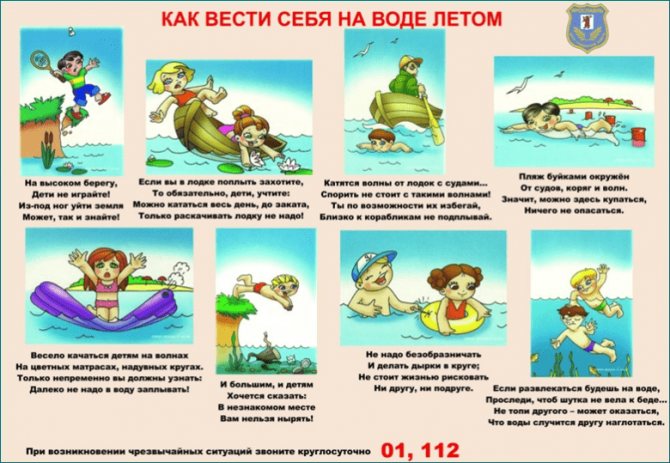
In the following illustration you can familiarize yourself with the basic rules of behavior in the forest. They apply to children and adults.
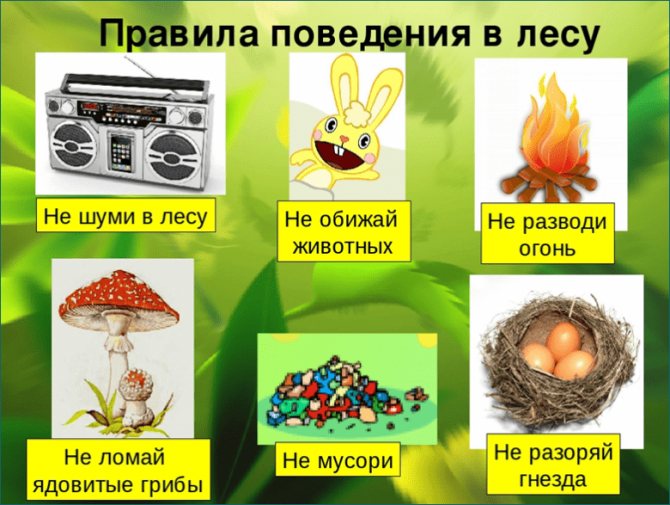
WHAT IS ETIQUETTE?
Etiquette is a set of norms and rules governing the behavior of people in society or a particular social group. When we talk about etiquette for children, we mean the rules of good behavior, first of all, in relation to adults, because they are the ones who can evaluate behavior as “good” or “bad” due to their experience.
Etiquette is divided into different types - there are both generally accepted rules and special etiquette for individual occasions (for example, official, religious, mourning). Children should be taught etiquette gradually, and for preschool age, those rules of good manners that children can apply in everyday situations are sufficient.
How to behave if your child is alone at home
Situations often arise that parents are forced to leave their son or daughter at home for a while. At the same time, it is extremely important to explain to the child how to behave in this case. The main rules include:
- You cannot open windows or a balcony if it is a multi-story building.
- It is prohibited to open the gas or use matches or lighters.
- Do not open the water and play with it.
- It is better to spend time quietly, reading books or watching cartoons.
- It is forbidden to invite guests without permission.
- In any emergency, you should call your parents.
- It is forbidden to go outside without leaving the apartment.
- If there is a fire, you need to call “01”, if strangers are breaking into the apartment, you need to call “02”.
Under no circumstances should you open doors to strangers. If a stranger asks if you are alone at home, say: “Dad is sleeping, you can come later.”
LEARNING BY PLAYING
You can also teach your child the rules of good manners through play. Conduct politeness lessons at home when you are studying with him or just playing in the nursery. You can play out situations with the help of dolls and your favorite toys - write a fairy tale about someone ill-mannered, act out a mini-scene, come up with etiquette games (“tea party with dolls”, “the bear went to visit”, etc.), and then - discuss and ask: “Who did the right thing? And why? Who will mom praise?" You can put on a whole theatrical performance for kids.
Read books on this topic and discuss which characters behave correctly and which ones are rude to others. There are many books on the topic of children's etiquette, here are some of them:
- “Etiquette for children of different ages”, A. Usachev;
- “Rules of Conduct”, E. Beaumont;
- “Polite words”, O. Korneeva;
- “Sociable Tales”, T. Shorygina;
- “The ABC of Politeness”, L. Vasilyeva-Gangnus;
- “School of politeness for small owners”, N. Ivanova, G. Shalaeva;
- “Rules of conduct for well-mannered children”, G. Shalaeva, O. Zhuravleva, O. Sazonova;
- “The most important rules of behavior for well-mannered children”, Harvest publishing house;
- “Etiquette for Fidgets”, Clever publishing house;
- “How to behave at the table. Etiquette for everyone in stories, poems, pictures,” ed. R. Dankova.
In preschool educational institutions, children are taught politeness according to specially developed programs. Teachers organize classes and teach children the rules of good manners, but this does not mean that parents should abandon this topic and rely only on teachers.
General rules of child behavior
We invite you to consider presentations on the topic of children's behavior in various places in verse. You can show them to your child too.
On the street

At the table
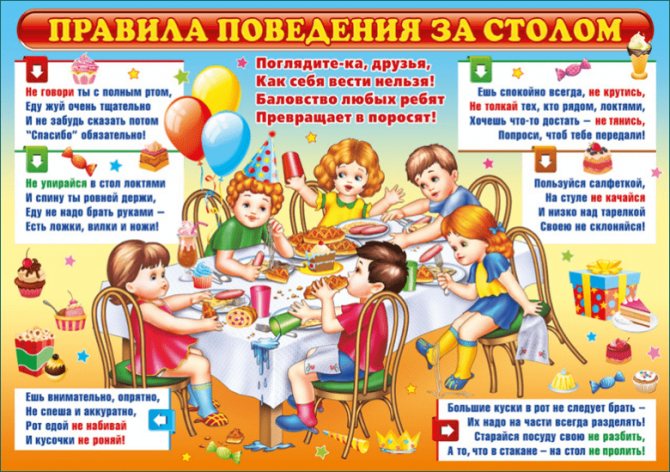
On road
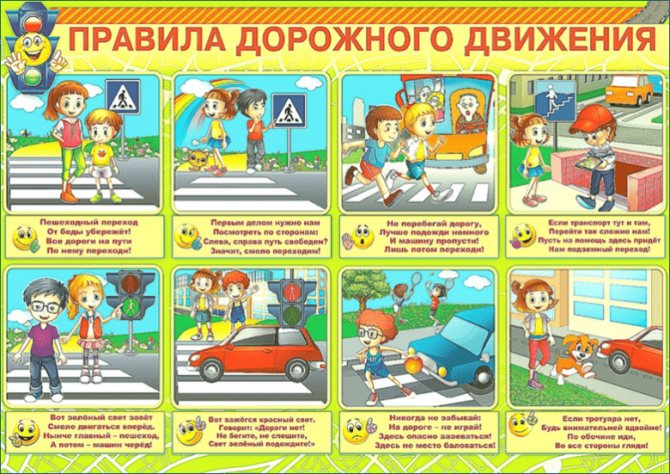
Away








